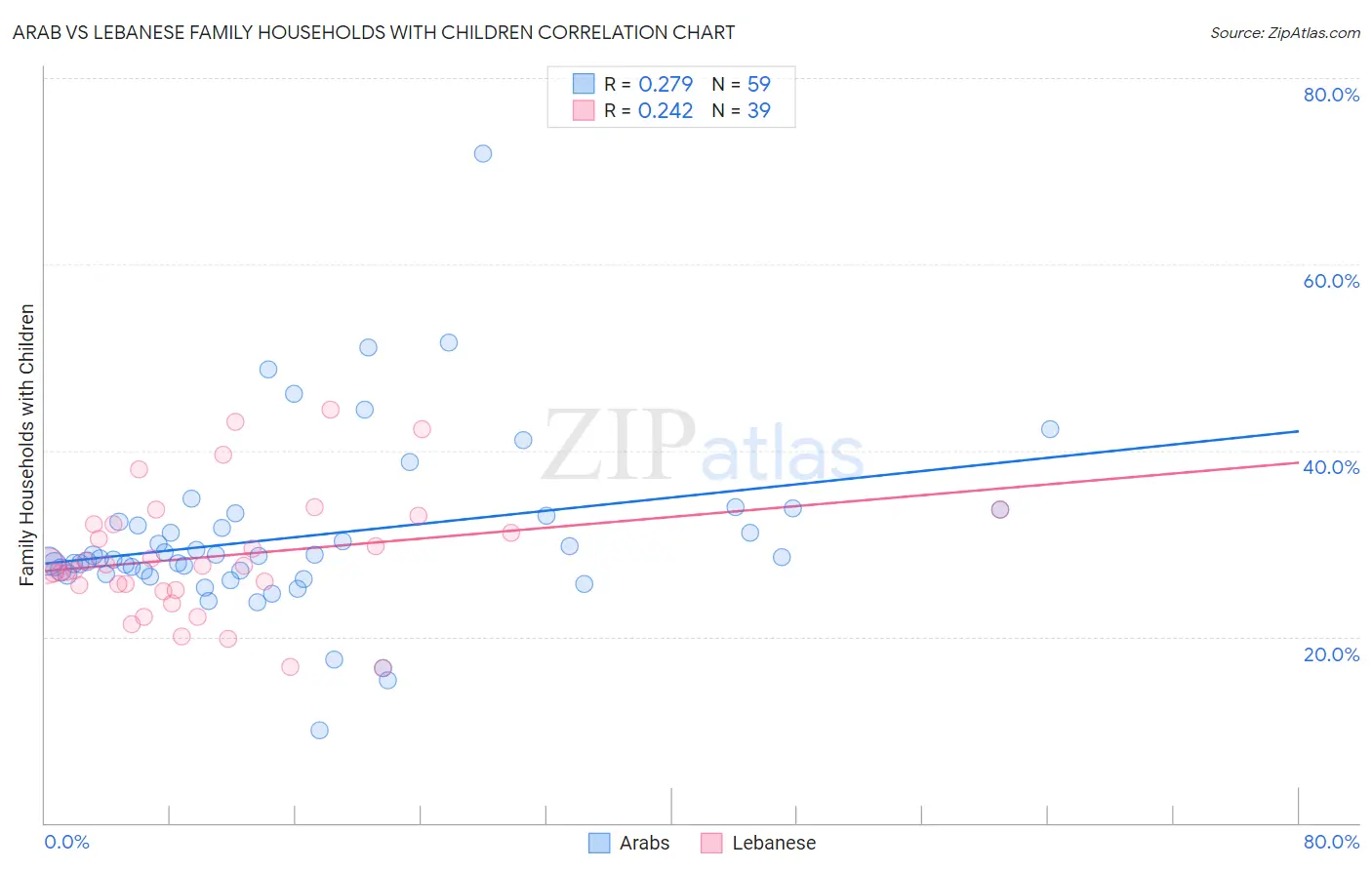Arab vs Lebanese Family Households with Children
COMPARE
Arab
Lebanese
Family Households with Children
Family Households with Children Comparison
Arabs
Lebanese
28.0%
FAMILY HOUSEHOLDS WITH CHILDREN
97.0/ 100
METRIC RATING
113th/ 347
METRIC RANK
27.7%
FAMILY HOUSEHOLDS WITH CHILDREN
87.4/ 100
METRIC RATING
131st/ 347
METRIC RANK
Arab vs Lebanese Family Households with Children Correlation Chart
The statistical analysis conducted on geographies consisting of 486,135,019 people shows a weak positive correlation between the proportion of Arabs and percentage of family households with children in the United States with a correlation coefficient (R) of 0.279 and weighted average of 28.0%. Similarly, the statistical analysis conducted on geographies consisting of 401,138,996 people shows a weak positive correlation between the proportion of Lebanese and percentage of family households with children in the United States with a correlation coefficient (R) of 0.242 and weighted average of 27.7%, a difference of 0.83%.

Family Households with Children Correlation Summary
| Measurement | Arab | Lebanese |
| Minimum | 10.0% | 16.7% |
| Maximum | 71.9% | 44.4% |
| Range | 61.9% | 27.8% |
| Mean | 30.8% | 28.6% |
| Median | 28.6% | 27.6% |
| Interquartile 25% (IQ1) | 26.7% | 25.0% |
| Interquartile 75% (IQ3) | 33.0% | 32.1% |
| Interquartile Range (IQR) | 6.2% | 7.1% |
| Standard Deviation (Sample) | 9.4% | 6.6% |
| Standard Deviation (Population) | 9.4% | 6.5% |
Demographics Similar to Arabs and Lebanese by Family Households with Children
In terms of family households with children, the demographic groups most similar to Arabs are Immigrants from Middle Africa (28.0%, a difference of 0.010%), South American Indian (28.0%, a difference of 0.020%), Immigrants from Africa (28.0%, a difference of 0.030%), Pakistani (27.9%, a difference of 0.16%), and Immigrants from Malaysia (27.9%, a difference of 0.16%). Similarly, the demographic groups most similar to Lebanese are Cajun (27.7%, a difference of 0.010%), Immigrants from Belize (27.7%, a difference of 0.080%), Immigrants from Eritrea (27.8%, a difference of 0.10%), Syrian (27.8%, a difference of 0.12%), and Belizean (27.8%, a difference of 0.14%).
| Demographics | Rating | Rank | Family Households with Children |
| Immigrants | Middle Africa | 97.0 /100 | #112 | Exceptional 28.0% |
| Arabs | 97.0 /100 | #113 | Exceptional 28.0% |
| South American Indians | 96.9 /100 | #114 | Exceptional 28.0% |
| Immigrants | Africa | 96.8 /100 | #115 | Exceptional 28.0% |
| Pakistanis | 96.0 /100 | #116 | Exceptional 27.9% |
| Immigrants | Malaysia | 95.9 /100 | #117 | Exceptional 27.9% |
| Central American Indians | 95.9 /100 | #118 | Exceptional 27.9% |
| Zimbabweans | 95.6 /100 | #119 | Exceptional 27.9% |
| Europeans | 95.4 /100 | #120 | Exceptional 27.9% |
| Immigrants | Western Asia | 93.6 /100 | #121 | Exceptional 27.9% |
| Immigrants | Zimbabwe | 92.8 /100 | #122 | Exceptional 27.8% |
| Immigrants | Northern Africa | 91.8 /100 | #123 | Exceptional 27.8% |
| Immigrants | Singapore | 90.8 /100 | #124 | Exceptional 27.8% |
| Ecuadorians | 90.8 /100 | #125 | Exceptional 27.8% |
| Immigrants | Ethiopia | 90.5 /100 | #126 | Exceptional 27.8% |
| Belizeans | 90.0 /100 | #127 | Exceptional 27.8% |
| Syrians | 89.7 /100 | #128 | Excellent 27.8% |
| Immigrants | Eritrea | 89.4 /100 | #129 | Excellent 27.8% |
| Cajuns | 87.6 /100 | #130 | Excellent 27.7% |
| Lebanese | 87.4 /100 | #131 | Excellent 27.7% |
| Immigrants | Belize | 85.7 /100 | #132 | Excellent 27.7% |